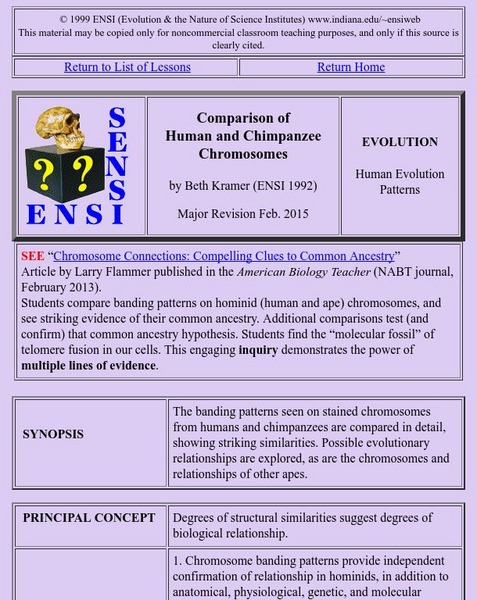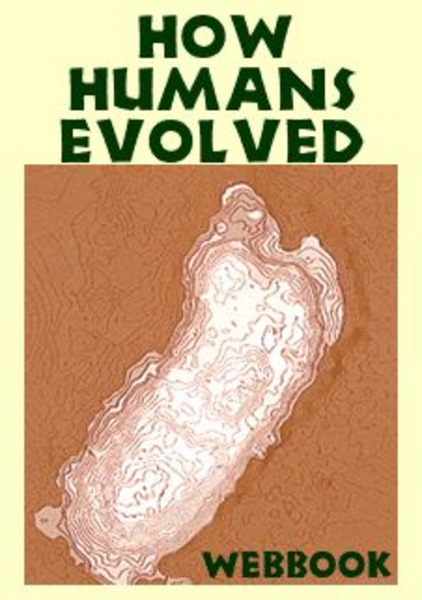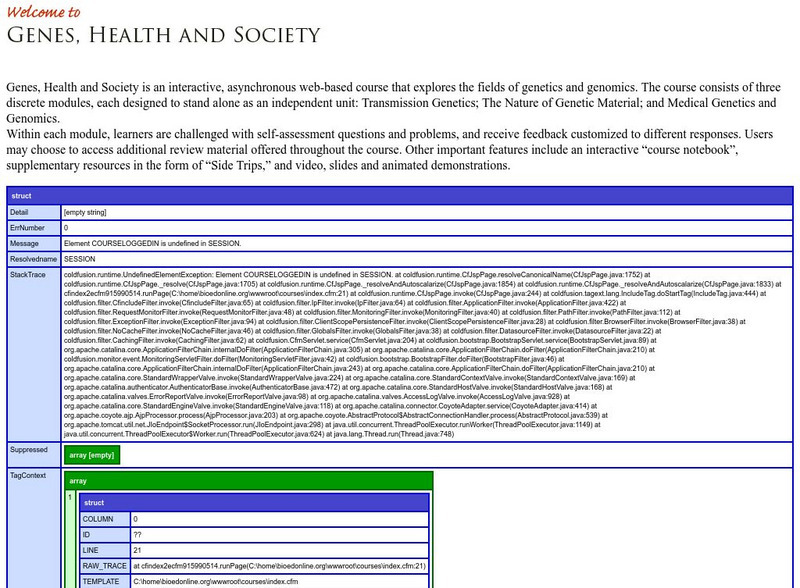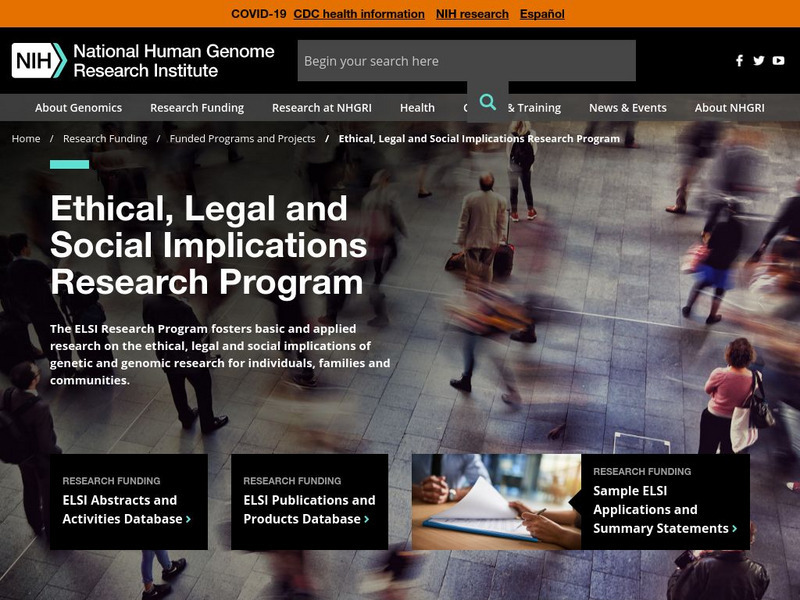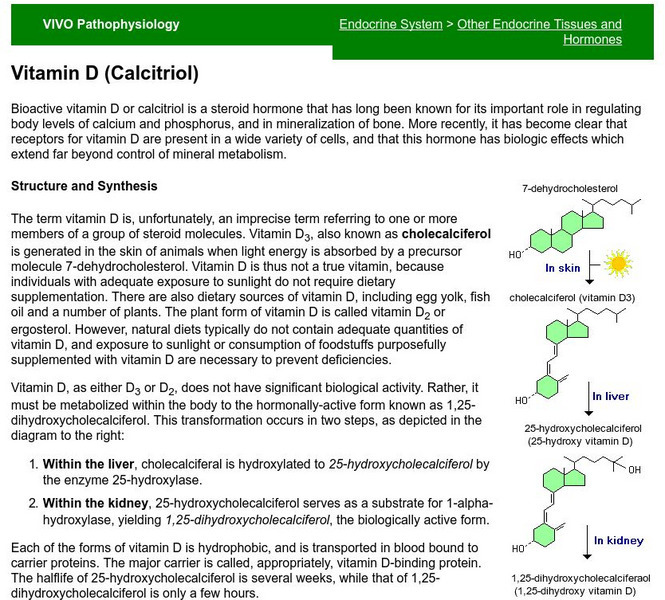PBS
Pbs News Hour Extra: The Human Genome Project, a Decade Later
This article reviews advances made by medical researchers since the complete mapping of the human genetic code ten years earlier. Although the expectation then had been that cures could be found for many diseases based on this new...
Indiana University
Ensi: Comparison of Human: Chimpanzee Chromosomes Lesson
This is a great lesson plan that combines Karoytypes and evolution. Students will recognize that the chromosomes of chimpanzees and humans are remarkably similar, then correlate that to their evolutionary relationship.
National Institutes of Health
Ncbi: Human Genome Resources
This site covers information on all the human chromosomes, has interesting illustrations as well.
University of Washington
Genome Sciences Education Outreach: Genetics of Taste (High School Level) [Pdf]
Multi-activity lesson plan in which students will use the scientific method to examine human variation in the ability to taste different substances.
W. W. Norton
W. W. Norton & Company: How Humans Evolved
This provides access to a webbook about How Humans Evolved. The following topics are covered: (1) How Evolution Works, (2) Primate Behavior and Ecology, (3) The History of Human Lineage, and (4) Evolution and Modern Humans. Each chapter...
University of Arizona
Biology Project: Karyotyping Activity
If you want an interactive way to practice karyotyping, this is it. There are three patient histories and karyotypes to use in diagnosing human genetic disorders. There is enough information on comparing chromosomes to get you started.
National Geographic
National Geographic: Genetic Markers: Connecting the Dots
Students first learn about genetic markers and how these can be used to learn more about ancient human migration. They then do an activity where they simulate passing on genetic markers, and problem solve to discover the 'migration' path...
Oak Ridge National Laboratory
Human Genome Project: Project Information
This site provides from the Human Genome Project provides basic information on the Human Genome Project. Among the items discussed is how genome sequencing is done, as well as information about the genome and proteome.
American Institute of Biological Sciences
Action Bioscience: Mitochondrial Dna Clarifies Human Evolution (2001)
DNA of the mitochondria has most commonly been used to construct evolutionary trees. New field of population genetics hopes to resolve important questions in migration theories that involve Aboriginies in Australia, North America, and...
BioEd Online
Bio Ed Online: Genes, Health, and Society
A web-based course which allows students to explore the fields of genetics and genomics. The three course modules are transmission genetics, the nature of genetic material, and medical genetics and genomics. Use of this resource requires...
Nature Research
Scitable: Genes and Disease
Investigate the genetic contributions to human diseases such as polydactyly, spina bifida, and cancer. Study the genetics of monogenic diseases, chromosomal diseases, and multifactorial with articles that explain the genetics...
Biotechnology Institute
Biotechnology Institute: Your World: Planting for the Future [Pdf]
This Biotechnology Institute's issue explores plant-made pharmaceuticals, using plants to manufacture useful proteins. It's one of the many aspects of biotechnology--the use of living organisms to benefit humanity.
Biotechnology Institute
Biotechnology Institute: Your World: Plant Biotechnology [Pdf]
As humans try to reach the goal of growing enough food to feed all the people, find out how biotechnology is used to help.
Science Buddies
Science Buddies: Computational Exploration of Protein Function
The DNA in our cells contains our "blueprints," but it's the proteins in our cells that do most of the work. The Human Genome Project has allowed us to start reading the blueprints, but we still don't understand what most of the proteins...
Science Buddies
Science Buddies: The Tree of Life I (Basic)
Imagine that a biologist arrived at your big family reunion and had no idea who were sisters, cousins, aunts, uncles, etc., but tried to sort it out by how all of you look. Just based on how you look, would s/he be able to guess whether...
American Institute of Biological Sciences
Action Bioscience: Designer Babies: Ethical Considerations
Ethical considerations are discussed in an article about the scientific ability to create "designer babies." Identify safety, moral use, effect on society, and whether it is for enhancement or therapy when humans have the option to...
American Institute of Biological Sciences
Action Bioscience: Primer on Ethics and Crossing Species Boundaries
Examine boundaries between science and ethics as scientists work with genetic testing and discovery.
National Human Genome Research Institute
Ethical, Legal, and Social Implications Research Program
This is the official division for researching the implications of the Human Genome Project. Find out about topics being discussed involving the ethics of the program, how it is socially accepted, and what sort of legislature is involved...
PBS
Pbs Learning Media: Dna and Protein Synthesis in the Cell
In this instructional activity, students learn how DNA fits into chromosomes, how chromosomes relate to the human body, DNA replication, and protein synthesis.
Other
Story md.com: Cancer: Understanding What Is Cancer
An in-depth look at cancer and the human body. Learn about cancer on a cellular level, types of cancer, how genetics and lifestyle risk factors play a part in cancer growth, and much more.
Colorado State University
Colorado State University: Vitamin D (Cholecalciferol, Calcitriol)
Learn how vitamin D is structured, synthesized and metabolized in the human body. Includes information on the health benefits of vitamin D and the effects of vitamin D deficiency.
BiologyWise
Biology Wise: Homozygous vs. Heterozygous
Genetic traits are described as homozygous or heterozygous based on allele similarity. Homozygosity and heterozygosity are explained in this resource. Includes a chart highlighting their differences and some examples that occur in humans.
Discovery Education
Discovery Education: Twins
This lesson encourages students to explore the phenomenon of identical twins, with emphasis on behavioral as well as genetic aspects. Teachers will appreciate extension activities, suggested readings, and links in addition to lesson plan...
TED Talks
Ted: Ted Ed: The Immortal Cells of Henrietta Lacks
Imagine something small enough to float on a particle of dust that holds the keys to understanding cancer, virology, and genetics. Luckily for us, such a thing exists in the form of trillions upon trillions of human, lab-grown cells...
Other popular searches
- Human Genetics Pedigree
- Human Genetics Lab
- Human Genetics Karyotyping
- Human Genetics Cloning
- Human Genetics Made Simple
- Human Genetics Introduction
- Basic Human Genetics
- Genetics and Human Behavior
- Human Genetics Intro
- Human Genetics Kl
- Human Genetics Kwl
- Human Genetics Finding Genes

